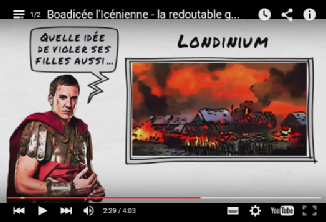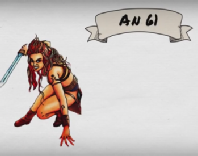Caratacus
*Caratācos",
Greek "Καράτακος";
variants Latin "Caractacus",
Greek "Καρτάκης"
was a historical British chieftain of the
Catuvellauni tribe ,
who led the British resistance to the Roman conquest.
The legendary Welsh character Caradoc and the legendary British king Arvirargus may be based upon Caratacus.
Caratacus is named by Dio Cassius as a son of the Catuvellaunian king Cunobelinus.
Based on coin distribution Caratacus appears to have been the protegé of his uncle Epaticcus, who expanded Catuvellaunian power westwards into the territory of the Atrebates. John Creighton, "Coins and power in Late Iron Age Britain", Cambridge University Press, 2000; Philip de Jersey (1996), "Celtic Coinage in Britain", Shire Archaeology] After Epaticcus died ca. 35, the Atrebates, under Verica, regained some of their territory, but it appears Caratacus completed the conquest, as Dio tells us Verica was ousted, fled to Rome and appealed to the emperor Claudius for help. This was the excuse used by Claudius to launch his invasion of Britain in the Summer of 43.
Cunobelinus had died some time before the invasion. Caratacus and his brother Togodumnus led the initial defence of the country against Aulus Plautius's four legions thought to have been around 40,000 men, primarily using guerrilla tactics. They lost much of the south-
Resistance to Rome
Finally, in 51, Scapula managed to defeat Caratacus in a set-
Caratacus himself escaped, and fled north to the lands of the Brigantes (modern Yorkshire where the Brigantian queen, Cartimandua handed him over to the Romans in chains. (This was one of the factors that led to two Brigantian revolts against Cartimandua and her Roman allies, once later in the 50s and once in 69, led by Venutius, who had once been Cartimandua's husband). With the capture of Caratacus, much of southern Britain from the Humber to the Severn was pacified and garrisoned throughout the 50s [A History of Britain, Richard Dargie (2007), p. 21] .
Legend places Caratacus' last stand at British Camp in the Malvern Hills, but the description of Tacitus makes this unlikely:
Although the Severn is visible from British Camp, it is nowhere near it, so this battle must have taken place elsewhere. A number of locations have been suggested, including a site near Brampton Bryan.
Captive in Rome
After his capture, Caratacus was sent to Rome as a war prize, presumably to be killed after a triumphal parade. Although a captive, he was allowed to speak to the Roman senate. Tacitus records a version of his speech in which he says that his stubborn resistance made Rome's glory in defeating him all the greater:
He made such an impression that he was pardoned and allowed to live in peace in Rome. After his liberation, according to Dio Cassius, Caratacus was so impressed by the city of Rome that he said "And can you, then, who have got such possessions and so many of them, covet our poor tents?" Dio Cassius,
Caratacus' name
- Caratacus' name appears as both "Caratacus" and "Caractacus" in manuscripts of Tacitus, and as "Καράτακος" and "Καρτάκης" in manuscripts of Dio. Older reference works tend to favour the spelling "Caractacus", but modern scholars agree, based on historical linguistics and source criticism, that the original Brythonic form was "*Caratācos", pronounced IPA|/ka.ra.taː'kos/, which gives the attested names “Caradog” in Welsh and "Carthach" in Irish. [Kenneth H. Jackson, "Queen Boudicca?", "Britannia" 10 p. 255, 1979]
Medieval British traditions
- Caratacus' memory may have been preserved in medieval British tradition. A genealogy in the Welsh Harleian MS 3859 (ca. 1100) includes the generations "Caratauc map Cinbelin map Teuhant", corresponding, via established processes of language change, to "Caratacus, son of Cunobelinus, son of Tasciovanus", preserving the names of the three historical figures in correct relationship. [; The Heirs of Caratacus] -
Caratacus and his relatives in medieval Welsh genealogies] - Caratacus does not appear in Geoffrey of Monmouth's "History of the Kings of Britain" (1136), although he appears to correspond to Arviragus, the younger son of Kymbelinus, who continues to resist the Roman invasion after the death of his older brother Guiderius. [Geoffrey of Monmouth, "Historia Regum Britanniae" ] In Welsh versions his name is Gweirydd, son of Cynfelyn, and his brother is called Gwydyr; [Geoffrey of Monmouth, "The History of the Kings of Britain", translated by Lewis Thorpe, 1973; Peter Roberts (trans), "The Chronicle of the Kings of Britain", 1811] the name Arviragus is taken from a poem by Juvenal. [Juvenal, "Satires", [http://www.thelatinlibrary.com/juvenal/4.shtml 4.126-
127] ] - Caradog, son of Bran, who appears in medieval Welsh literature, has also been identified with Caratacus, although nothing in the medieval legend corresponds except his name. He appears in the Mabinogion as a son of Bran the Blessed, who is left in charge of Britain while his father makes war in Ireland, but is overthrown by Caswallawn (the historical Cassivellaunus, who lived a century earlier than Caratacus). ["The Mabinogion": " [http://www.sacred-
texts.com/neu/celt/mab/mab22.htm Branwen, daughter of Llyr] "] The Welsh Triads agree that he was Bran's son, and name two sons, Cawrdaf and Eudaf. [Rachel Bromwich, "Trioedd Ynys Prydein", University of Wales Press, 1963; Triads from the [http://www.ancienttexts.org/library/celtic/ctexts/triads1.html Red Book of Hergest] and [http://www.ancienttexts.org/library/celtic/ctexts/triads2.html Peniarth MS 54] ] - Modern traditions
- Caradog only began to be identified with Caratacus after the rediscovery of the works of Tacitus, and new material appeared based on this identification. An 18th century tradition, popularised by the Welsh antiquarian and forger Iolo Morganwg, credits Caradog, on his return from imprisonment in Rome, with the introduction of Christianity to Britain. Iolo also makes the legendary king Coel a son of Caradog's son Cyllen. [Iolo Morganwg, "Triads of Britain" , , , , , , , , , , ]
- Another tradition, which has remained popular among British Israelites and others, makes Caratacus already a Christian before he came to Rome, Christianity having been brought to Britain by either Joseph of Arimathea or St. Paul, and identifies a number of early Christians as his relatives. [This article formerly made reference to a passage of Dio Cassius that described Caratacus as a "barbarian Christian". This derived from a transcription error in the version of the Cary translation of Dio online on the [http://penelope.uchicago.edu/Thayer/E/Roman/home.html Lacus Curtius] website, which has now been corrected to read "barbarian chieftain" as per the print edition ( [http://penelope.uchicago.edu/Thayer/E/Roman/Texts/Cassius_Dio/61*.html#33.3c Dio 61.33.3c] ). See also the [http://www.gutenberg.org/etext/10883 Foster translation] at [http://www.gutenberg.org/ Project Gutenberg] , which also reads "barbarian chieftain".]
- One is Pomponia Graecina, wife of Aulus Plautius, the conqueror of Britain, who as Tacitus relates, was accused of following a "foreign superstition", generally considered to be Christianity. [Tacitus, "Annals" [http://www.perseus.tufts.edu/cgi-
bin/ptext?lookup=Tac.+Ann.+13.32 13:32] ] Tacitus describes her as the "wife of the Plautius who returned from Britain with an ovation", which led John Lingard (1771 – 1851) to conclude, in his "History and Antiquities of the Anglo- Saxon Church", that she was British; ["We are, indeed, told that history has preserved the names of two British females, Claudia and Pomponia Graecina, both of them Christians, and both living in the first century of our era." Lingard, John, "History and Antiquities of the Anglo- Saxon Church", 2nd. ed. Newcastle, Walker, 1810 Vol. I., p1.] however, this conclusion is a misinterpretation of what Tacitus wrote. An ovation was a military parade in honour of a victorious general, so the person who "returned from Britain with an ovation" is clearly Plautius, not Pomponia. This has not prevented the error being repeated and disseminated widely. - Another is Claudia Rufina, a historical British woman known to the poet Martial. [Martial, "Epigrams", XI:53 (ed. & trans. D. R. Shackleton Bailey, Harvard University Press, 1993)] Martial describes Claudia's marriage to a man named Pudens, [Martial, "Epigrams" IV:13] almost certainly Aulus Pudens, an Umbrian centurion and friend of the poet who appears regularly in his "Epigrams". It has been argued since the 17th century [Baronius, "Annales Ecclesiastici", Antwerp, 1614; Archbishop James Ussher (1637), "British Ecclesiastical Antiquities", Oxford; Cardinal Michael Alford (1663), "Annales Ecclesiae Britannicae: Regia Fides, Vol 1"; Williams, J. (1848)(Archdeacon), contributor John Abraham, "Claudia and Pudens", Herauld] that this pair may be the same as the Claudia and Pudens mentioned as members of the Roman Christian community in "2 Timothy" in the New Testament. ["2 Timothy" 4:21 -
"Eubulus saluteth thee, and Pudens, and Linus, and Claudia, and all the brethren."] Some go further, claiming that Claudia was Caratacus' daughter, and that the historical Pope Linus, who is described as the "brother of Claudia" in an early church document, was Caratacus' son. Pudens is identified with St. Pudens, and it is claimed that the basilica of Santa Pudenziana in Rome, and with which St. Pudens is associated, was once called the "Palatium Britannicum" and was the home of Caratacus and his family. - This theory was popularised in a 1961 book called "The Drama of the Lost Disciples" by George Jowett, but Jowett did not originate it. He cites renaissance historians such as Archbishop James Ussher, Caesar Baronius and John Hardyng, as well as classical writers like Caesar, Tacitus and Juvenal, although his classical cites at least are wildly inaccurate, many of his assertions are unsourced, and many of his identifications entirely speculative. He also regularly cites "St. Paul in Britain", an 1870 book by R. W. Morgan, and advocates other tenets of British Israelism, in particular that the British are descended from the lost tribes of Israel. [George Jowett, "The Drama of the Lost Disciples", Covenant Books, 1961]


Boudicca joined forces with the Trinovantes and together they raised an army to fight the Romans.
Boudicca's army captured and burned London Colchesterahcf St Albans. The Romans were forced-
The Romans killed anyonewho had fougt them Boudicca poisoned herself to prevent the romans catching her.....

